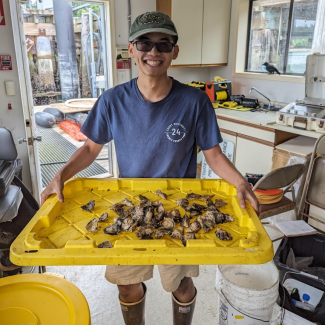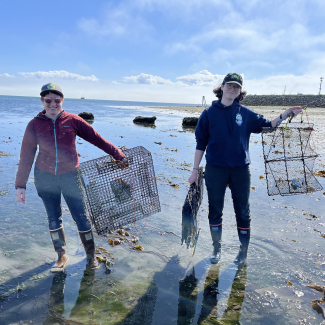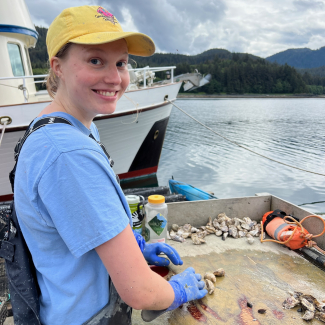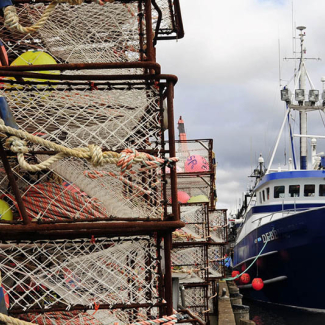Seafood plays an essential role in feeding the world’s growing population. Healthy fish populations lead to healthy oceans and it's our responsibility to be a part of the solution. The resilience of our marine ecosystems and coastal communities depend on sustainable fisheries.

Fishermen aboard the F/V Miss Sue participate in a midwater rockfish exempted fishing permit. (Image credit: John Rae. With permission.)
What is a fishery?
A fishery can be many things: an occupation, an industry, or a season for catching seafood, particularly fish and shellfish. Fisheries can also refer to the locations where seafood is caught, or the business of catching the species.
Fisheries are composed of three different types of fishing:
- Commercial: Catching and marketing fish and shellfish for profit.
- Recreational: Fishing for sport or pleasure.
- Subsistence: Fishing for personal, family, and community consumption or sharing.
Shellfish growers in the Pacific Northwest are seeing a rise in mass die-off events in their crops of Pacific oysters (Crassostrea gigas), with growing concerns that such events may be worsened with climate change and ocean acidification. During his 2023 Hollings internship with the Northwest Fisheries Science Center Ocean Acidification Lab, Nicholas Chang worked on a project that aims to improve the resiliency of oyster aquaculture operations to these threats.
How does NOAA manage U.S. fisheries?
Many factors go into managing fisheries, or ensuring that fish populations stay healthy and sustainable. NOAA Fisheries' role is to support our country’s seafood supply, protect ecosystem health and sustainability, create jobs, boost the economy, and provide fishing opportunities for all types of fishermen. In 2017, U.S. commercial and recreational fisheries contributed to over 1.7 million jobs and over $244 billion in national fishery sales.
NOAA Fisheries manages animals that maintain balanced and thriving ocean ecosystems, including fish, shellfish, marine mammals, and sea turtles. NOAA Fisheries and their regional partners use ecosystem-based fisheries management methods to meet sustainable fishery goals. Important ecosystem components, such as protected species, biodiversity, and habitats, must be taken into account along with fishery industry priorities to help achieve these goals. Recognizing the interconnectedness of these factors helps maintain resilient and productive ecosystems ー including the human communities on which they depend ー as they respond to climate, habitat, ecological, and other environmental changes.
Hi everyone, my name is Nicole, and I’m a 2022 Hollings scholar. This summer, I interned at the Kachemak Bay National Estuarine Research Reserve in Homer, Alaska. I worked as a part of the Harmful Species Program, with my mentor Jasmine Maurer, the lead of the program. My project specifically focused on how we can make crab traps more effective for marine invasive species, such as the European green crab (Carcinus maenus).
Sustainable fisheries
Sustainable management of fisheries means that fishery harvest rates are regulated to ensure healthy fish populations for future generations. NOAA Fisheries manages fish populations through stock assessments, which measure the impact of fishing on fish and shellfish subpopulations. They project harvest levels that maximize the number of fish that can be caught every year while preventing overfishing, or the removal of too many fish. NOAA Fisheries works to protect the marine ecosystem, and where necessary, will work to rebuild depleted stocks.
The U.S. is a global leader in responsibly managed fisheries and sustainable seafood. As of June 2020, NOAA has rebuilt 47 fish stocks — including chinook salmon and Atlantic sea scallops — and has created some of the most sustainably managed fisheries in the world by working closely with commercial, recreational, and tribal fishermen. Sustainably managing fisheries requires sound science, innovative management approaches, effective enforcement, meaningful partnerships, and strong public participation.
Effective fishery management starts with accurate scientific information about fish and fisheries. Using information such as stock assessments, cooperative research, and socioeconomics help to make the best fishery management decisions.
Scientists are kind of like detectives answering questions about our natural world. I’m Kate Laboda, a NOAA Hollings Scholar, and I spent my summer internship Nancy-Drewing it at an oyster farm in Juneau, Alaska. I was trying to find out how many males and females were in the farm’s oyster population to aid in developing a local oyster hatchery. We found something very curious … no females!
Fisheries policies
States usually manage fisheries from their coastline out to three miles into the ocean. The U.S. exclusive economic zone is a 4.4-million-square-mile area that extends from three to 200 nautical miles off the coast of the United States, which NOAA Fisheries is legally responsible for managing. NOAA Fisheries works with federal, regional, state, tribal, and U.S. territorial partners to ensure the sustainable fisheries management.
NOAA Fisheries works with regional fisheries management councils to monitor the status of fish stocks, set catch limits, enforce regulations, and reduce bycatch. NOAA Fisheries’ five regional offices, six science centers, and more than 20 laboratories across the U.S. and U.S. territories work with partners to ensure the sustainable management of the nation’s fisheries.
My name is Grace Cajski, and I’m a 2022-2024 Hollings scholar. I’m interested in how coastal communities are feeding themselves in a changing world. This summer, I joined the Milford Laboratory GoPro team in their project to understand the potential ecological benefits of aquaculture gear, specifically oyster cages.
Fisheries and community
In order to preserve marine life, the communities that depend on them must be involved. Fishermen, indigenous communities, whale watching operators, and other members of coastal communities all interact with marine resources in different and vital ways. Fisheries and protected species can be managed in a way that works best for everyone by understanding both the social and economic aspects of communities.
Economic and socio-cultural analysis help managers evaluate the costs and benefits of different activities, prioritize needs, and encourage policies that maximize societal benefits from ocean and coastal resources. Various federal laws require organizations to examine the social and economic impacts of policies and regulations at the community level.
Robert Bland has 19 years of experience as a fisheries observer. His new blog shares what it’s like fishing for Atlantic deep-sea red crab—a unique insight to a fishery many don't know about.
EDUCATION CONNECTION
Even if you are hundreds of miles from a coastline, fisheries may still be important in your life. Have you ever gone fishing in your local waterway? Do you eat seafood? Recreational fishermen in the United States take millions of fishing trips per year and seafood consumption in the United States is rising. Cutting-edge science is making aquaculture, or seafood farming, safer and more sustainable. As such an important aspect of American culture, how does your community engage with fisheries?





